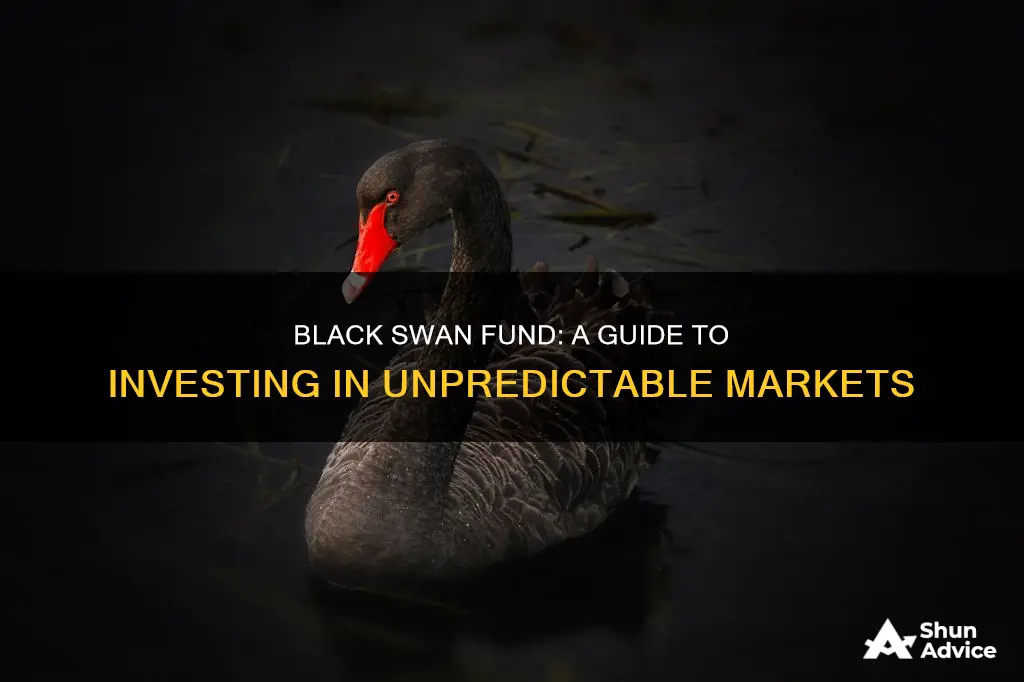
A Black Swan fund is an investment fund that aims to profit from sharp downturns in the market. The name comes from the idea of a black swan as an unpredictable, rare event with negative consequences. The concept of the Black Swan was popularised by Nassim Nicholas Taleb, who wrote a book of the same name. Black Swan funds gained popularity following the financial crisis of 2007-2008, where some investors made huge profits. However, Black Swan events are highly unpredictable, and it is challenging to create a business model around them. This paragraph will discuss how one might invest in a Black Swan fund and the potential risks involved.
What You'll Learn

Diversification
To protect against these unpredictable events, investors should diversify their portfolios across different asset classes. For example, an investor with a long position in equities would have suffered significant losses in 2008. However, if they had diversified their portfolio to include liquid assets and gold, the damage would have been much lower. Even in the worst Black Swan situations, some asset classes will hold their value, so diversification can protect your portfolio's overall value.
Gold, in particular, is worth considering as part of your diversification strategy. Historically, gold prices have appreciated significantly during periods of geopolitical crisis and embargoes, such as the Arab oil embargo between 1971 and 1979, when gold prices rose by nearly 2400%. Similarly, gold rallied after the 9/11 attacks and the 2008 financial crisis.
Another way to diversify your portfolio is through hedging. This involves using contrarian strategies, such as buying stock puts or Nifty put options, to reduce the risk of long positions. While these strategies entail a cost, they can be worth the investment to protect against potential Black Swan events.
Additionally, automatic rebalancing can help beat Black Swan events by ensuring you book profits at higher valuations and have cash on hand when valuations are too high. This provides a safety net, ensuring you have cash when attractive value investments emerge in the aftermath of a Black Swan event.
Finally, you can diversify by investing in funds specifically designed to protect against Black Swan events, such as the Amplify BlackSwan Growth & Treasury Core ETF (SWAN). This fund invests roughly 90% of its assets in intermediate U.S. treasury bonds and 10% in long-dated call options on the S&P 500. By taking advantage of the low correlation between stocks and treasury bonds, SWAN aims to provide downside protection while still capturing some upside potential.
Thematic Funds: Diversify Your Portfolio, Invest in the Future
You may want to see also

Liquidity
For example, let's consider a Black Swan fund that spends 10% of its portfolio value annually on these options. If the fund is relatively large, finding sellers for these options in sufficient quantities may be difficult. As a result, the fund might struggle to build a sizeable enough position to generate substantial returns.
Additionally, the illiquid nature of these investments can also impact exit strategies. Black Swan funds aim to profit from extreme market moves, but timing the exit correctly can be challenging. If a black swan event occurs, the fund manager must decide when to take profits. Without a fundamental view on the value of the underlying security, it can be difficult to determine the optimal time to exit the position.
Furthermore, the liquidity of the underlying assets can also impact the ability to take profits. In some cases, the market for these out-of-the-money options may be thin, leading to challenges in finding buyers when it's time to sell. This lack of liquidity can result in lower prices than expected or even difficulty in exiting the position altogether.
Therefore, when considering investing in a Black Swan fund, it is crucial to assess the liquidity of the options being purchased. Understanding the potential challenges in entering and exiting these positions can help investors make more informed decisions about the viability and potential returns of this investment strategy.
Index Funds: A Beginner's Guide to Investing
You may want to see also

Gold
One source suggests that investors should focus on "true diversification" in their portfolios to prepare for black swan events. This includes investing in negatively correlated assets like gold, commodities, and actively managed funds. The SPDR Gold MiniShares Trust (GLDM) is offered as an example of an ETF that tracks these alternative assets.
Another source mentions gold as a potential addition to the Amplify BlackSwan Growth & Treasury Core ETF (SWAN). The author suggests that gold could be a prudent addition to the SWAN ETF, as it reduces portfolio volatility and risk due to its usual uncorrelation with stocks and bonds. They also note that gold hedges against uncertainty, which is a key characteristic of black swan events.
Overall, gold is mentioned as a possible investment to hedge against black swan events due to its potential to reduce portfolio volatility and provide protection during uncertain times.
Smart Mutual Fund Investments: 16K Options
You may want to see also

Hedging
The Amplify BlackSwan Growth & Treasury Core ETF (SWAN) is an example of a fund that aims to protect against unpredictable, adverse events. The fund's target notional exposure can be described as 70/90 stocks/bonds. It relies on the uncorrelation between stocks and treasury bonds, which tends to be amplified during periods of market turmoil.
SWAN's ITM LEAPS on SPY means its call option exposure grows as the stock market rises and shrinks as the market falls. This allows the fund to participate more in stock market gains during bull markets and get more protective as the market drops.
SWAN has delivered on its promise to protect against Black Swan events in its relatively short lifespan. When the market dropped by 30% in March 2020, SWAN dropped by only 8%.
While SWAN is suitable for a risk-averse investor, it may not be the best option for those seeking maximum returns. The fund's fee of 0.49% is high compared to broad index funds, and it may not provide the same level of protection in the future due to historically low bond yields.
Best Debt Funds to Invest in Amid Rising Rates
You may want to see also

Automatic rebalancing
To effectively invest in a Black Swan fund, automatic rebalancing ensures that the portfolio remains aligned with the fund's strategy and risk parameters. This process involves periodically adjusting the portfolio's asset allocation to return it to its target composition. For example, a Black Swan fund may allocate 10% of its portfolio value each year to purchasing out-of-the-money options, as mentioned by Erik Kobayashi-Solomon. By utilising automatic rebalancing, the fund can maintain this allocation strategy without requiring manual adjustments.
The benefits of automatic rebalancing are twofold. Firstly, it helps to manage risk by ensuring the portfolio does not deviate significantly from its intended strategy. Black Swan funds rely on capitalising on rare events, so maintaining the correct allocation of capital is crucial. Secondly, automatic rebalancing provides a systematic approach to investing, removing emotional decision-making from the process. This is particularly important in the context of Black Swan investing, as these events are unpredictable and can create a sense of panic or uncertainty among investors.
Additionally, automatic rebalancing can help investors avoid the pitfalls of hindsight bias and normalcy bias. As Nassim Nicholas Taleb highlights, Black Swan events appear obvious in hindsight, but are challenging to predict beforehand. By relying on a systematic rebalancing approach, investors can make more objective decisions, reducing the impact of hindsight or normalcy biases.
In summary, automatic rebalancing is a critical tool for Black Swan fund investors, helping to manage risk, maintain discipline, and avoid behavioural biases. By utilising this approach, investors can ensure their portfolios remain aligned with the unique characteristics and requirements of Black Swan funds.
Mutual Funds: Where Are Your Investments Going?
You may want to see also
Frequently asked questions
A Black Swan fund is an investment fund that aims to profit from sharp market downturns. The name is based on the black swan theory, which describes extremely rare and unpredictable events with severe negative consequences.
Black Swan funds spend a certain amount of capital each year to buy out-of-the-money options on assets that the fund manager believes are ripe for an extremely unlikely, black swan event. The idea is to profit from sharp market declines by buying options that increase in value when the market falls.
Notable examples of black swan events include the 1997 Asian Financial Crisis, the 2000 Dot-com Bubble, the 2001 9/11 Terrorist Attacks, the 2008 Financial Crisis, and the 2020 Global Pandemic.
Black Swan funds carry risks that may not be readily apparent. They can be difficult to implement due to liquidity issues and the challenge of determining when to take profits. Additionally, predicting black swan events and their impact on the market is highly unpredictable, making it challenging to create a consistent business model around them.







